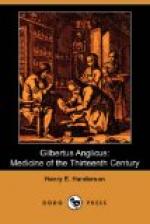We will terminate our hasty review of diseases discussed in the Compendium by an abstract of Gilbert’s views on vesical calculus and its treatment, which cover more than fifteen pages of his work.
Stone and gravel arise from various viscous superfluities in the kidneys and bladder, which occasion difficulty in micturition. Stone is produced by the action of heat upon viscous moisture, sublimating the volatile elements and condensing the denser portions. Putrefication of stone in the bladder is the result of three causes, viz., consuming heat, viscous matter and stricture of the meatus. For consuming heat acting on viscous material retained by reason of stricture of the meatus, by long action dries up, coagulates and hardens the moisture. This is particularly manifest in boys who have a constricted meatus.
Stones are thus generated not only in the kidneys and bladder, but also even in the stomach and the intestines, whence they are ejected by vomiting or in the stools. Indeed they may also be found occasionally in the lungs, the joints and other places. They are comparatively rare in women, in consequence of the shortness of the urethra and the size of their meatus.
Sometimes calculi occur in the bladder, sometimes in one kidney and occasionally in both kidneys. The symptoms produced by their presence vary in accordance with the situation of the concretion. If the stone is in the kidney, the foot of the side affected is numb (stupidus), the spine on the affected side is sore and there is difficulty of micturition and considerable gravelly sediment in the urine. If the stone is increasing in size, the quantity of sediment also increases, but if the stone is fully formed and confirmed, the amount of sediment decreases daily, and the urine becomes milky both in the kidneys and the bladder. A stone in the bladder occasions very similar symptoms, together with pain in the peritoneum and pubes, dysuria and strangury, and sometimes the appearance of blood and flocculi (trumbos?) in the urine. Patients suffering from vesical calculus are always constipated, and the dysuria may increase to the degree called furia, a condition not without some danger.
Three things are necessary in the cure of stone, viz., a spare and simple diet, the use of diuretics and a moderate amount of exercise. It should, however, be remarked that confirmed stone is rarely or never cured, except by a surgical operation.... If a boy has a clear and watery urine after it has been sandy, if he frequently scratches his foot, has involuntary erections and finally obstruction in micturition, I say that he has a stone in the neck of his bladder. If now he be laid upon his back with his feet well elevated, and his whole body be well shaken, if there is a stone present it is possible that it may fall to the fundus of the bladder. Afterwards direct the boy to bear down (ut exprimat se) and try




